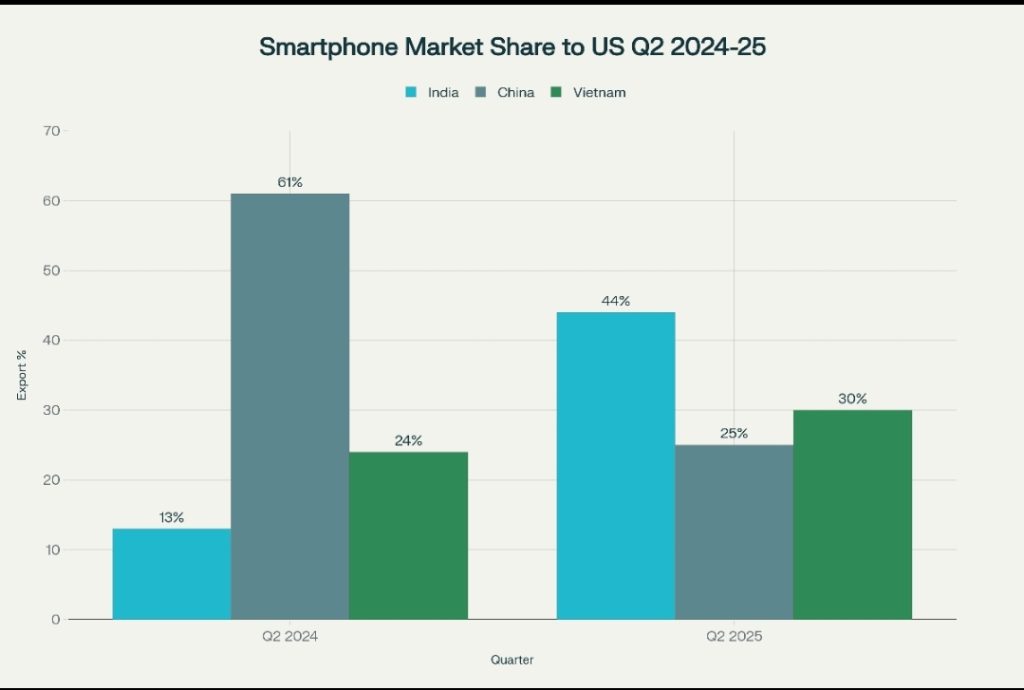India’s Smartphone Manufacturing Revolution: How Trade Wars Transformed Global Supply Chains
Something extraordinary happened in the global technology sector during Q2 2025. For the first time in modern manufacturing history, India overtook China as the leading smartphone exporter to the United States. This shift represents far more than simple statistics. It marks the dawn of a new era in global electronics manufacturing.
Moreover, the numbers tell an incredible story. India’s share of US smartphone imports surged from just 13% to 44% year-over-year. Meanwhile, China’s dominance collapsed dramatically, falling from 61% to 25% over the same period. This transformation happened within twelve months, fundamentally reshaping supply chains that took decades to establish.

Apple Leads the Manufacturing Migration
The transformation begins with one company’s strategic pivot. Apple spearheaded this massive shift through its aggressive “China Plus One” strategy. Additionally, the iPhone maker’s exports from India climbed 53% year-over-year, surpassing 20 million units for the first time in H1 2025. Remarkably, Apple assembled $22 billion worth of iPhones in India during fiscal 2025, marking a 60% increase from the previous year.
Tim Cook, Apple’s CEO, confirmed this historic milestone during the company’s earnings call. Furthermore, he stated that “the vast majority of iPhones sold in the US have a country of origin of India”. This represents the first time Apple’s flagship product manufacturing base has shifted so dramatically from China.
The iPhone 16 emerged as the most exported model from India, accounting for 18% of the country’s total smartphone exports. Subsequently, Apple plans to manufacture all iPhone 17 models in India for the first time, including Pro variants. This marks another watershed moment in the company’s manufacturing strategy.
Production-Linked Incentive Scheme Drives Success
Behind India’s manufacturing surge lies a masterful policy instrument. The government’s Production-Linked Incentive (PLI) scheme generated remarkable results, producing 19 times its investment value. Specifically, the scheme contributed $13.03 billion in revenue while disbursing only $687.3 million in incentives.
The PLI scheme created nearly 300,000 direct jobs and 600,000 indirect jobs in the smartphone ecosystem. Particularly noteworthy, the industry became the largest employment generator for women in mid-skilled, blue-collar positions. Between FY23 and FY25, Tata Electronics received $241.81 million while Foxconn received $328.22 million in PLI incentives.
India’s smartphone value addition increased from 12% to 20% over five years. This improvement outpaced China and Vietnam during comparable stages of their electronics manufacturing expansion. Consequently, India jumped from 23rd to become the world’s third-largest smartphone exporter.
Foxconn and Tata Drive Manufacturing Expansion
Two manufacturing giants lead India’s smartphone production revolution. Foxconn maintains a commanding 65% share of iPhone production in India, generating revenues of $10.5 billion in 2024. Recently, the Taiwanese giant committed an additional $1.5 billion investment in its Indian operations.
Foxconn’s new $2.6 billion facility near Bengaluru began test production of iPhone 16 models at 500 units per hour. Once fully operational by 2027, this site will employ 50,000 workers. Additionally, Foxconn directed 97% of its iPhone exports from India to the US between March and May 2025.
Tata Electronics emerged as Apple’s second major partner, controlling 35% of iPhone production by 2025. The company acquired Wistron and secured a 60% stake in Pegatron’s Indian operations. Tata’s exports jumped 63% in March 2025, reaching $612 million. This strategic positioning makes Tata a crucial player in India’s manufacturing ecosystem.
Global Supply Chain Diversification Accelerates
The transformation reflects broader supply chain realignment beyond Apple. Samsung’s exports from India to the US surged 268% year-over-year. The South Korean giant shipped 945,000 smartphones to America between January and May 2025, compared to 645,000 units in the previous year.
Motorola achieved remarkable growth, becoming the fastest-growing smartphone exporter from India. The company’s exports jumped 700% to over one million units, with 99% destined for the US market. Motorola historically relied on China for US supply, but shifted production after facing potential 55% tariffs on Chinese imports versus 26% on Indian goods.
Vietnam also benefits from supply chain diversification, claiming 30% of US smartphone imports in Q2 2025. This represents a six percentage point increase year-over-year. Vietnam’s electronics exports reached $126.5 billion in 2024, accounting for more than one-third of total national exports.
Trade War Impacts Drive Manufacturing Shifts
Geopolitical tensions fundamentally altered global electronics manufacturing patterns. China’s smartphone exports to the US crashed 72% in April 2025, hitting the lowest levels since 2011. The dramatic collapse exceeded the overall 21% drop in Chinese exports to America.
Trump administration policies created unprecedented pressure on manufacturers. The US imposed tariffs reaching 145% on Chinese goods while China responded with 125% tariffs on American products. Even though smartphones received temporary exemptions, semiconductor tariffs affect production costs throughout the supply chain.
Apple incurred approximately $800 million in tariff-related costs during Q2 2025 alone. The company estimates these costs will rise to $1.1 billion in Q3 2025. Consequently, shifting assembly to India, which benefits from tariff exemptions on smartphones, helps Apple mitigate further expenses.
Employment and Economic Transformation
India’s smartphone manufacturing revolution generated massive employment opportunities. The mobile phone manufacturing sector created 1.2 million direct and indirect jobs over the past decade. Between 2023 and 2028, the sector is expected to generate an additional 800,000 new positions.
The industry particularly benefits women workers, providing financial independence and valuable work experience. Approximately 55,000 trainees were hired in 2024 through apprenticeship programs. The Electronic Sector Skill Council of India facilitated these placements across various manufacturing facilities.
Job profiles in high demand include electronics technicians, assembly operators, line supervisors, quality control inspectors, and supply chain managers. Manufacturing wages range from $2.50 per hour in India compared to $7.10 per hour in China. This cost advantage attracts manufacturers seeking competitive production bases.
Manufacturing Capacity and Utilization Challenges
Despite remarkable growth, India faces capacity utilization challenges. The country’s mobile phone production capacity surpassed 500 million units by end-2024, but actual production remains around 250 million units annually. Approximately 200 million units serve domestic demand while the remainder, predominantly iPhones, supports exports.
Key manufacturers benefiting from PLI schemes include Dixon Technologies, Samsung Electronics, Tata Electronics, and Foxconn. These companies leveraged government incentives to drive production and expand capacity. However, domestic manufacturers like Lava International, Karbonn, and Micromax struggle to meet production targets.
Global smartphone demand weakness affects manufacturing utilization rates. Nearly half of India’s mobile phone production capacity remains idle. Companies adapted by diversifying into telecom equipment, wearables, or alternative sectors.
Future Outlook and Strategic Implications
India’s smartphone manufacturing transformation positions the country as a critical global technology hub. The government projects the sector will reach $126 billion by 2025-26. Additionally, India is set to become the world’s second-largest 5G market after China by 2024.
However, tariff uncertainties create ongoing challenges. Trump’s recent 25% tariff announcement on Indian goods introduces policy risks. While smartphones remain temporarily exempt, the situation could change rapidly. Apple plans to scale iPhone production to 60 million units in 2025, up from 35-40 million in 2024-2Apple.com5.
The manufacturing transformation extends beyond smartphones to broader electronics components. India aims to achieve deeper value chain integration, particularly in semiconductor production. Government initiatives like the CHIPS Act equivalent and additional PLI scheme allocations support this strategic direction.
Conclusion: A New Manufacturing Paradigm
India’s rise as the leading smartphone exporter to the US represents more than industrial policy success. It demonstrates how geopolitical pressures, strategic government intervention, and corporate adaptation can rapidly reshape global manufacturing landscapes. The transformation from 13% to 44% market share within twelve months illustrates the speed of modern supply chain realignment.
Furthermore, this shift establishes India as an indispensable player in global technology supply chains. Companies like Apple no longer view India merely as a market but as a critical manufacturing base. The PLI scheme’s 19x return on investment proves that targeted industrial policies can achieve remarkable results when properly executed.
Nevertheless, challenges remain significant. Tariff uncertainties, capacity utilization issues, and global demand fluctuations create ongoing risks. India must continue strengthening its manufacturing ecosystem, improving infrastructure, and developing local component capabilities to maintain competitive advantages.
The smartphone manufacturing revolution ultimately positions India at the center of global technology transformation. As trade tensions reshape international commerce, India’s strategic location between East and West becomes increasingly valuable. This transformation marks the beginning of India’s emergence as a comprehensive technology manufacturing superpower.

